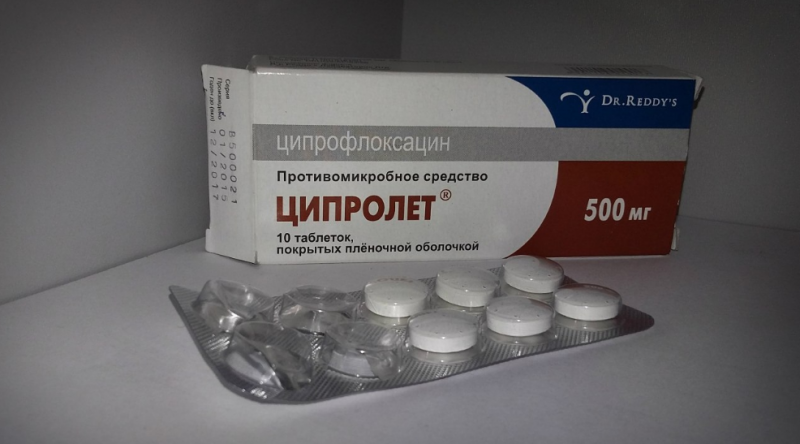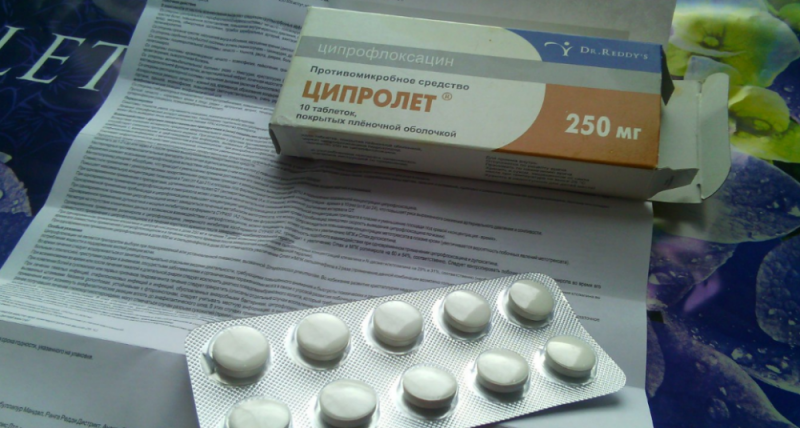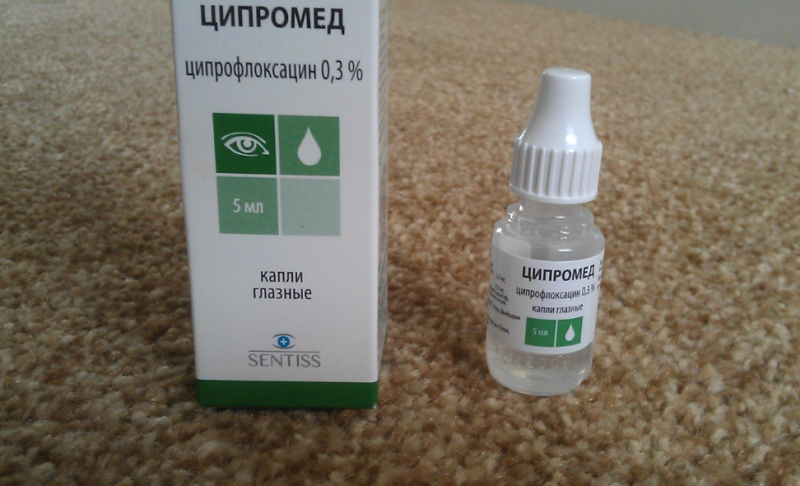The prescription antibiotic Ciprolet is used for bacterial infections of organs and tissues: the respiratory tract, kidneys, throat, female reproductive system, etc. When used, exact adherence to prescriptions is necessary.
Material Content:
Description of release forms and composition
The medication is made in three types:
- pills;
- eye drops 0.3% 5 ml;
- solution for injection 0.2% 100 ml.
All medicines include ciprofloxacin (a group of fluoroquinolones). It has a wide antibacterial spectrum of action: it violates the reproduction of bacteria, prevents the spread of infection.
Additional components depend on the form of release, allow the active substance to better penetrate into organs and tissues and act.
| Solution | Eye drops | Pills |
|---|---|---|
| Sodium chloride | Sodium chloride | Corn starch |
| Disodium edetate | Disodium edetate | Cellulose |
| Hydrochloric acid | Hydrochloric acid | Silicon dioxide |
| Water for injections | Water for injections | Talc |
| Lactic acid | Benzalkonium chloride | Magnesium stearate |
| Sodium hydroxide | ||
| Lemon acid |
Tablets are available in two dosages - 250 mg and 500 mg in 10 tablets.
There is an additional form of the drug - tablets Tsiprolet A. Apart from the antibacterial component, they include tinidazole, which has an antimicrobial, antiprotozoal effect and enhances the properties of the first.
Indications for the use of the antibiotic Tsiprolet
Instructions for use vary depending on the variety.
Ciprolet 500 mg tablets, less often in a lower dosage, are taken for inflammation caused by an infectious process in the following organs and tissues:
- Airways;
- kidneys
- urinary and reproductive system;
- ENT organs (ear, throat, nasopharynx, etc.);
- Gastrointestinal tract, including dentition;
- bile ducts, gall bladder;
- integuments, mucous membranes;
- bones and muscles.
And also the tablet form is used as a preventive measure to reduce the likelihood of complications in patients with HIV, AIDS, taking immunosuppressants.
For the same purposes, a medicine is prescribed in the form of infusions and Tsiprolet A. They have a stronger anti-inflammatory, antibacterial effect.
Eye drops are used for the following eye diseases:
- mucosal inflammation (conjunctivitis);
- inflammatory process occurring in the edges of the eyelid (blepharitis);
- blepharoconjunctivitis;
- barley;
- ulcerative lesion of the cornea, keratitis and keratoconjunctivitis of a bacterial nature.
In addition, drip installations are used before and after surgery, to prevent the development of complicated conditions, after injuries, with a burn of the cornea by welding.
Instructions for use and dosage
Eye drops are used in 1-2 drops every 2-4 hours, depending on the severity of the disease. After reducing the onset of symptoms, the frequency of instillation is reduced. The course of treatment is determined by the ophthalmologist depending on the disease, its course, and ranges from 5 to 7 days on average.
Tablets are produced in two dosages - 250 mg and 500 mg. The second is used for the normal course of diseases and for complications. A medicine with a lower dose is the drug of choice for patients with low weight and kidney disease (chronic failure). The medication is taken on a tablet twice a day, the course of treatment is determined individually. On average, it is from 7 to 10 days.
Tablets should be drunk on an empty stomach and washed down with a glass of clean water.
The solution for infusion is administered dropwise, slowly, twice a day, possibly a combination with a solution of sodium chloride or dextrose. Treatment is carried out in a hospital under the supervision of specialists.
During pregnancy and lactation
These two periods are a contraindication for all varieties of the drug. If it is necessary to prescribe for hepatitis B, breast-feeding should be stopped.
Drug Interactions and Alcohol Compatibility
During therapy with any type of Cyprolet, it is necessary to exclude alcohol and ethanol-containing liquids.
With the joint prescription of the drug with the following groups of drugs, reactions are observed:
- with didanosine - antibiotic absorption decreases, its effectiveness is lost;
- with theophylline - the toxic effect of the drug from shortness of breath and bronchial asthma increases;
- with antacids (Almagel, Maalox, Fosfalugel, etc.) - the absorption of the antibacterial drug is reduced, therefore, two drugs should be used with a minimum time difference of 4 hours;
- with anticoagulants - the risk of bleeding and prolongation of their duration;
- with cyclosporine - a negative effect on the kidneys.
Contraindications, side effects and overdose
Restrictions on the appointment depend on the form of release.
Common to all species are:
- individual intolerance;
- pregnancy, hepatitis B;
- pseudomembranous colitis;
- age up to 18 years, except for eye drops, which can be used from a year.
The combined antibiotic Ciprolet A has additional contraindications: diseases of the central nervous system, blood and blood formation organs. It contains tizanidine, therefore, in order to prevent overdose and undesirable side reactions, it is impossible to additionally use agents in which this substance is present.
Eye drops Tsiprolet can not be used for keratitis of a viral nature.
The severity of adverse reactions depends on the form of the medication, compliance with recommendations, individual characteristics of the patient.Eye drops are used topically, when instilled, blurred vision, allergic manifestations at the site of contact, double vision and temporary color perception are possible.
After using other forms, nausea, vomiting, stomach pain, dyspepsia, jaundice, headache and dizziness, sweating, disturbed taste and smell, tinnitus, heart rate, decreased pressure and sensation of hot flashes, allergic manifestations are possible.
There is no evidence of an overdose of eye drops used according to the instructions. In case of intentional or accidental internal use, it is necessary to rinse the stomach and take absorbent medications (activated carbon, Polysorb, Enterosgel, Polyphepan, Filtrum-Sti, Enterodes).
When using doses of tablets and infusions above the maximum, overdose symptoms are possible: convulsions, reversible disorders of the urinary system. There is no special antidote for treatment. It is necessary to rinse the stomach, use symptomatic therapy (from heat, pain) and give the patient a sufficient amount of clean water. If necessary, visit a specialist.
Analogues of the drug
Each form of Ciprolet medicine has its own analogues or substitutes.
All types of products are manufactured in India.
With the same active substance and indications for use, there are similar preparations:
- eye drops - Tsipromed (India), Betaciprol (Russia, additionally used to treat bacterial infections of the ears), Ciprofloxacin (RF);
- drip intravenous solution - Basigen (India), Ifipro (India), Quintor (India), Ciprinol (India), Ciprofloxacin (Russia);
- tablets - Vero-Ciprofloxacin (RF), Quintor (India), Ciprinol (India), Ciprobay (Italy), Ciprofloxacin (Russia and with the prefix Teva Israel), Cifran (India).
The analogue of Tsiprolet A is the Indian drug Tsifran ST.
With intolerance to ciprofloxacin (the main substance of the drug), analogues from the same group can be used: Levofloxacin, Lomefloxacin, Moxifloxacin, Norfloxacin and others.
Levofloxacin also kills many bacteria, comes in the form of:
- tablets under the trade names Levofloxacin (Russia), Levofloxacin-Teva (Israel), Glevo (India), Levolet P (India), Tavanik (France), Floracid (Russia);
- eye drops under the names Levofloxacin (Russia), Signicef (India);
- infusion solution from various manufacturers.
Tablets can not be used until 18 years old, during pregnancy, HB, epilepsy. Local allergic reactions, undesirable effects on the stomach and liver, and nervous system are possible. Drops have the same restrictions for use, except Signicef. According to the instructions, they can be used with caution as prescribed by a specialist from 1 year. The disadvantage of Levofloxacin is the high price.
Lomefloxacin is available in the form of tablets: Lomefloxacin, Lomflox, Lofox, Lomacin affect many types of pathogens (bacteria). Contraindications - pregnancy, hepatitis B, hypersensitivity. In children's practice it is applied since 15 years.
Moxifloxacin in pharmacies is presented in the form of solutions and tablets. The advantage of the drug is the use of 1 time per day exclusively by adults, the course depends on the disease. Restrictions on the appointment - HB, pregnancy, intolerance to the components.
Norfloxacin affects many types of bacteria, more often prescribed for kidney diseases. It is taken twice a day. The duration of admission is affected by the stage of the disease and severity. In acute mild form, it is 5 days. With exacerbation of a chronic disease, up to 10 days are taken. Known under the trade names: Norfloxacin, Nolitsin, Normax, Norbactin. In children's practice can be used from 15 years.
Normax - eye drops with norfloxacin, are used 4 times a day. Contraindications are the same as in tablets.
When treating with tablet counterparts, certain rules must be adhered to. Medications should be taken with an equal interval of 12 hours - in the morning and in the evening. The exception is moxifloxacin, which is drunk once a day at the same time.
Do not interrupt a course of treatment defined by a doctor. With therapy with these drugs, improvement usually occurs on the third day, so many patients reduce the course to 3-4 days. Such improper actions lead to the insensitivity of microorganisms to fluoroquinolones and the further ineffective use of these drugs.
The drug Tsiprolet and its analogues destroy microorganisms, pathogens of various infections of the skin, respiratory tract, genitourinary system and the whole body. Differ in reasonable price and usability. Subject to instructions, patients do not report serious adverse reactions.















